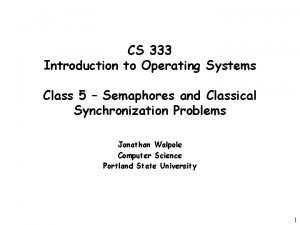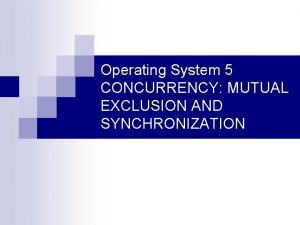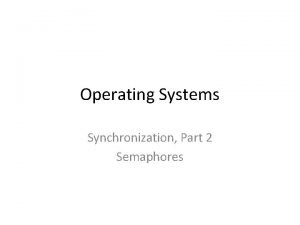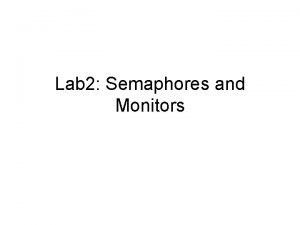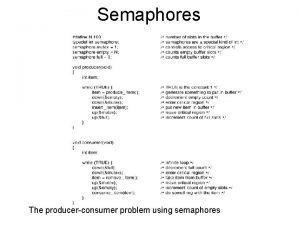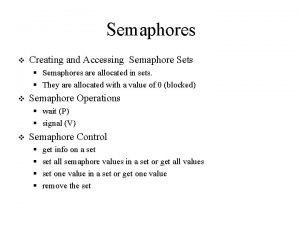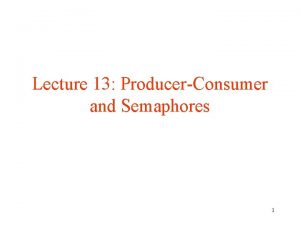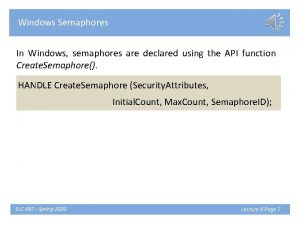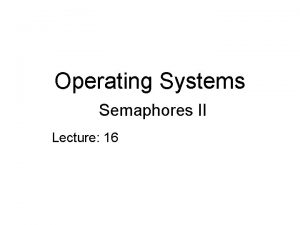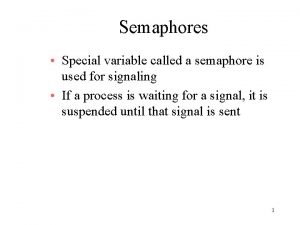Review ProducerConsumer using Semaphores define N 100 Semaphore















![void take_forks(int i) { down(&mutex); state[i]=HUNGRY; test(i); up(&mutex); down(&s[i]); } //i: philosopher number, from void take_forks(int i) { down(&mutex); state[i]=HUNGRY; test(i); up(&mutex); down(&s[i]); } //i: philosopher number, from](https://slidetodoc.com/presentation_image_h2/52126965c6863b0c176d56cc6cf82741/image-16.jpg)





- Slides: 21

Review: Producer-Consumer using Semaphores #define N 100 Semaphore mutex = 1; Semaphore empty = N; Semaphore full = 0; // number of slots in the buffer // controls access to critical region // counts empty buffer slots // counts full buffer slots void producer(void){ int item; while (TRUE){ item = produce_item(); down(&mutex); down(&empty); insert_item(item); up(&mutex); up(&full); } } // generate something to put in buffer // enter critical region // decrement empty count // put new item in buffer // leave critical region // increment count of full slots void consumer(void){ int item; while (TRUE){ down(&mutex); down(&full); item = remove_item(); up(&mutex); up(&empty); } Dead Lock! // enter critical region // decrement full count // take item from buffer // leave critical region // increment count of empty slots } 1

Monitor n Monitor: a collection of procedures, variables and data structures that grouped together n n n Provide an easy way to achieve mutual exclusion n n Processes can call procedures in a monitor, but cannot access its internal variables (private!) Only one procedure can be active in a monitor at any instant. (How to guarantee? ) Compiler takes charge of mutual exclusion, not the programmer. But how about synchronization? (P-C problem) 2

Condition Variables n Two operations: n n wait(cond): block the caller on cond. And allow another process previously prohibited from entering the monitor to enter now. (avoid deadlock) signal(cond): wake up one process blocked on cond n n Only appear as the final statement in a monitor procedure (why? ) Condition variables are not counters. n To avoid lost-wakeup problem, the wait must come before signal. 3

Producer-Consumer With Monitors Monitor Producer. Consumer condition full, empty; integer count; Procedure producer; Begin while true do begin procedure insert(item: integer); begin item : = produce_item; if count = N then wait(full); Producer. Consumer. insert(item); insert_item(item); end count : = count + 1; if count = 1 then signal(empty) End; end; Procedure consumer; function remove: integer; Begin Not a system begin while true do if count = 0 then wait(empty); call remove = remove_item; begin count : = count – 1; item : = Producer. Consumer. remove; if count = N – 1 then signal(full) consume_item(item) end; end count : =0; End monitor; 4

Sleep/Wakeup Vs. Monitor n Why sleep/wake fails? n n With monitor, that cannot happen n The wake-up call is sent before the sleep call. Only one process can be active in a monitor Wait call is always before signal Monitors in programming language n Keyword synchronized in Java 5

Message Passing n Two primitives (system calls) n n Send(destination, &message) Receive(destination, &message) n n Acknowledgement of messages n n Receiver blocks until receiving one message Sender resends messages if timeout Buffered messages/rendezvous n Mail box: hold up to n messages n n Block senders if mail box is full Rendezvous: block senders if receivers are not ready 6

Producer-Consumer With Message Passing #define N 100 void consumer(void){ int item, i; message m; for(i = 0; i < N; i++) send(producer, &m); while (TRUE){ receive(producer, &m); item = extract_item(&m); send(producer, &m); } } void producer(void){ int item; message m; while (TRUE){ item = produce_item(); receive(consumer, &m); build_message(&m, item); send(consumer, &m); } } // number of slots in the buffer // send N empties // extract item from message // send back empty reply // message buffer // wait for an empty to arrive // construct a message to send // send item to consumer 7

Barriers: Synchronizing A Group Barrier A B D C Time D Time A Barrier C A Barrier B B C D Time 8

Summary n n n Race conditions Critical regions Mutual exclusion n No two processes are in their critical regions at the same time Synchronization Busy waiting, sleep and wakeup, semaphore, mutex, monitor, message passing, barrier n Please compare these primitives 9

Outline n n n Processes Threads Inter-process communication (IPC) Classical IPC problems Scheduling 10

Dining Philosophers Problem n Philosophers: loop of eating + thinking n n Pick up two forks, one at a time No predefined order in acquiring folks Philosopher process forks resources. 3 Goals: n n n No deadlock No starvation Efficient 4 4 3 2 0 1 11

Naïve Solution #define N 5 Void philosopher(int j){ while (TRUE){ think(); take_fork(j); take_fork((j+1) % N); eat(); put_fork(j); put_fork((j+1) % N); } } // number of philosophers // j: philosopher number, from 0 to 4 // philosopher is thinking // take left fork, blocked if fork unavailable // take right fork; % is modulo operator // yum-yum, spaghetti // put left fork back on the table // put right fork back on the table What if all philosophers take left forks simultaneously? A deadlock! 12

Solutions with Starvation n What if a philosopher put down left fork if the right fork is not available? n n If all philosophers action simultaneously, the program runs indefinitely without progress Starvation! n n n All the processes continue to run indefinitely but fail to make any progress. Different from deadlock. What about waiting for a random time if the right fork is not available? n n May work in practice, low failure probability Not absolutely safe! 13

Safe Solution May Not Be Good n Allow at most ONE philosopher eat at a time n n n Definitely safe, no competition forks Low efficiency, at least 3 forks are free Better solution: a philosopher only eat if neither neighbor is eating n n Safe, no starvation, no deadlock. Maximal parallelism, at most 2 philosophers can eat at a time. 14

A Solution for Dining Philosopher Problem #define N 5 #define LEFT (i+N-1)%N #define RIGHT (i+1)%N #define THINKING 0 #define HUNGRY 1 #define EATING 2 int state[N]; semaphore mutex = 1; semaphore s[N] = 0; //number of philosophers //i’s left number //i’s right number //philosopher is thinking //philosopher is trying to get forks //philosopher is eating //array to keep track of everyone’s state //mutual exclusion for critical regions //one semaphore per philosopher void philosopher(int i) { while (TRUE){ think(); take_forks(i); eat(); put_forks(i); //i: philosopher number, from 0 to N-1 } //repeat forever //philosopher is thinking //acquire two forks or block //eating //put both forks back on table } 15
![void takeforksint i downmutex stateiHUNGRY testi upmutex downsi i philosopher number from void take_forks(int i) { down(&mutex); state[i]=HUNGRY; test(i); up(&mutex); down(&s[i]); } //i: philosopher number, from](https://slidetodoc.com/presentation_image_h2/52126965c6863b0c176d56cc6cf82741/image-16.jpg)
void take_forks(int i) { down(&mutex); state[i]=HUNGRY; test(i); up(&mutex); down(&s[i]); } //i: philosopher number, from 0 to N-1 void put_forks(int i) { down(&mutex); state[i]=THINKING; test(LEFT); test(RIGHT); up(&mutex); } //i: philosopher number, from 0 to N-1 //enter critical region //record the fact that philosopher i is hungry //try to acquire 2 forks //exit critical region //block if forks were not acquired //enter critical region //philosopher has finished eating //see if left neighbor can now eat //see if right neighbor can eat //leave critical region void test(int i) { } if ( state[i]==HUNGRY && state[LEFT] !=EATING && state[RIGHT]!=EATING){ state[i]=eating; up(&s[i]); } 16

Saltshakers Solution n n Previous solution has starvation problem. Why? Saltshakers solution: adding two tokens to the table, perhaps saltshakers n n each philosopher first collects a saltshaker before attempting to collect forks, then eats, and then puts the forks and saltshaker back. A philosopher has to wait if he/she fails to collect a saltshaker or a fork. Deadlock free (why? ), starvation free (assumption? ), but less concurrency (how? ) 17

The Readers and Writers Problem n Multiple readers/writers of a database n n First solution: A writer is admitted only if there is no reader n n No access to database when one is writing A writer may never get in! Improved solution: A writer blocks readers after her n Less concurrency 18

The Sleeping Barber Problem n n n One barber, one barber chair, and n chairs for waiting customers Barber: working or sleeping (semaphore) Customer: (semaphore) n n If the barber is sleeping, wake him up (lost signal) If the barber is cutting other’s hair n n n If there are empty chairs, wait Otherwise, leave Program the barber and the customers without getting into race conditions. 19

semaphore mutex For mutual exclusion int waiting a copy of customers semaphore customers For synchronization semaphore barbers For synchronization 20

semaphore customers = 0; semaphore barbers = 0; semaphore mutex = 1; int waiting = 0; void barber(void) { while (TRUE){ down(&customers); down(&mutex); waiting=waiting-1; up(&barbers); up(&mutex); cut_hair(); } } void customer(void) { down(&mutex); if ( waiting < CHAIRS) { waiting=waiting+1; customers up(&customers); up(&mutex); down(&barbers); get_haircut(); }else { up(&mutex); } } //#customers waiting for service //#barber waiting for customers //for mutual exclusion //#customers are waiting (not being cut) //go to sleep if #customers is 0 //acquire access to waiting //decrement count of waiting customers //one barber is ready to cut hair //release “waiting” //cut hair //enter critical region //if no free chair, leave //increment count of waiting //wake up barber if necessary //release access to “waiting” //go to sleep if barbers=0 //be seated and serviced //shop is full, leave 21
 100 100 100 100 100
100 100 100 100 100 Difference between strong and weak semaphore in os
Difference between strong and weak semaphore in os Sleeping barber problem in os
Sleeping barber problem in os Sleeping barber problem solution using semaphore in c
Sleeping barber problem solution using semaphore in c Mutex puzzle
Mutex puzzle Drawbacks of semaphore
Drawbacks of semaphore The main disadvantage of mutex lock is
The main disadvantage of mutex lock is Semaphore provide a primitive yet powerful and flexible
Semaphore provide a primitive yet powerful and flexible Types of semaphores
Types of semaphores Semaphore in os
Semaphore in os Semaphores
Semaphores Semaphores and monitors
Semaphores and monitors 40 sayısının yüzde 15 fazlası kaçtır
40 sayısının yüzde 15 fazlası kaçtır 200+200+100+100
200+200+100+100 Box plot gcse
Box plot gcse Malloc lab 100/100
Malloc lab 100/100 1453-1337
1453-1337 100+100=200
100+100=200 100 iops/gb and 100,000 iops per volume oci
100 iops/gb and 100,000 iops per volume oci 100 + 100 200
100 + 100 200 C/100=f-32/180=k-273/100
C/100=f-32/180=k-273/100 What's 100 + 100
What's 100 + 100


